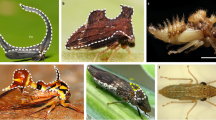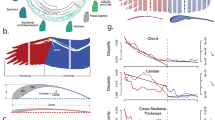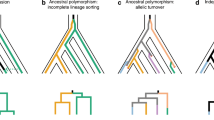Abstract
Identifying the genomic changes that control morphological variation and understanding how they generate diversity is a major goal of evolutionary biology. In Heliconius butterflies, a small number of genes control the development of diverse wing colour patterns. Here, we used full-genome sequencing of individuals across the Heliconius erato radiation and closely related species to characterize genomic variation associated with wing pattern diversity. We show that variation around colour pattern genes is highly modular, with narrow genomic intervals associated with specific differences in colour and pattern. This modular architecture explains the diversity of colour patterns and provides a flexible mechanism for rapid morphological diversification.
This is a preview of subscription content, access via your institution
Access options
Access Nature and 54 other Nature Portfolio journals
Get Nature+, our best-value online-access subscription
$29.99 / 30 days
cancel any time
Subscribe to this journal
Receive 12 digital issues and online access to articles
$119.00 per year
only $9.92 per issue
Buy this article
- Purchase on Springer Link
- Instant access to full article PDF
Prices may be subject to local taxes which are calculated during checkout






Similar content being viewed by others
References
Dasmahapatra, K. K. et al. Butterfly genome reveals promiscuous exchange of mimicry adaptations among species. Nature 487, 94–98 (2012).
Lamichhaney, S. et al. Evolution of Darwin’s finches and their beaks revealed by genome sequencing. Nature 518, 371–375 (2015).
Brawand, D. et al. The genomic substrate for adaptive radiation in African cichlid fish. Nature 513, 375–381 (2014).
Lamas, G. in Hesperioidea – Papilionoidea. Gainesville, Florida: Association for Tropical Lepidoptera (ed. Lamas, G. ) 261–274 (Scientific Publisher, 2004).
Nijhout, H. F. The Development and Evolution of Butterfly Wing Patterns. (Smithsonian Institution, 1991).
Chouteau, M., Arias, M. & Joron, M. Warning signals are under positive frequency-dependent selection in nature. Proc. Natl Acad. Sci USA 113, 2164–2169 (2016).
Naisbit, R. E., Jiggins, C. D. & Mallet, J. Disruptive sexual selection against hybrids contributes to speciation between Heliconius cydno and Heliconius melpomene . Proc. Biol. Sci. 268, 1849–1854 (2001).
Turner, J. R. G. A tale of two butterflies. Nat. Hist. 84, 28–37 (1975).
Sheppard, P. M., Turner, J. R. G., Brown, K. S., Benson, W. W. & Singer, M. C. Genetics and the evolution of Muellerian mimicry in Heliconius Butterflies. Phil. Trans. R. Soc. B Biol. Sci. 308, 433–610 (1985).
Joron, M. et al. A conserved supergene locus controls colour pattern diversity in Heliconius butterflies. PLoS Biol. 4, e303 (2006).
Papa, R. et al. Multi-allelic major effect genes interact with minor effect QTLs to control adaptive color pattern variation in Heliconius erato . PLoS ONE 8, e57033 (2013).
Kronforst, M. R., Kapan, D. D. & Gilbert, L. E. Parallel genetic architecture of parallel adaptive radiations in mimetic Heliconius butterflies. Genetics 174, 535–539 (2006).
Kapan, D. D. et al. Localization of mìllerian mimicry genes on a dense linkage map of Heliconius erato . Genetics 173, 735–757 (2006).
Reed, R. D. et al. optix drives the repeated convergent evolution of butterfly wing pattern mimicry. Science 333, 1137–1141 (2011).
Martin, A. et al. Diversification of complex butterfly wing patterns by repeated regulatory evolution of a Wnt ligand. Proc. Natl Acad. Sci. USA 109, 12632–12637 (2012).
Nadeau, N. et al. The gene cortex controls mimicry and crypsis in butterflies and moths. Nature 534, 106–110 (2016).
Martin, A. et al. Multiple recent co-options of Optix associated with novel traits in adaptive butterfly wing radiations. EvoDevo 5, 7 (2014).
Carroll, S. B. Evo-Devo and an expanding evolutionary synthesis: a genetic theory of morphological evolution. Cell 134, 25–36 (2008).
Gallant, J. R. et al. Ancient homology underlies adaptive mimetic diversity across butterflies. Nat. Commun. 5, 1–10 (2014).
Van’t Hof, A. E. The industrial melanism mutation in British peppered moths is a transposable element. Nature 534, 102–105 (2016).
Rosser, N., Dasmahapatra, K. K. & Mallet, J. Stable Heliconius butterfly hybrid zones are correlated with a local rainfall peak at the edge of the Amazon basin. Evolution 68, 3470–3484 (2014).
Supple, M., Papa, R., Hines, H. M., McMillan, W. O. & Counterman, B. A. Divergence with gene flow across a speciation continuum of Heliconius butterflies. BMC Evol. Biol. 15, 204 (2015).
Hines, H. M. et al. Wing patterning gene redefines the mimetic history of Heliconius butterflies. Proc. Natl Acad. Sci. USA 108, 19666–19671 (2011).
Mallet, J. & Barton, N. H. Strong natural selection in a warning-color hybrid zone. Evolution 43, 421–431 (1989).
Kapan, D. D. Three-butterfly system provides a field test of mìllerian mimicry. Nature 409, 18–20 (2001).
Supple, M. A et al. Genomic architecture of adaptive color pattern divergence and convergence in Heliconius butterflies. Genome Res. 23, 1248–1257 (2013).
Martin, A. et al. Diversification of complex butter flywing patterns by repeated regulatory evolution of a Wnt ligand. Proc. Natl Acad. Sci. USA 109, 12632–12637 (2012).
Martin, S. H. & Van Belleghem, S. M. Exploring evolutionary relationships across the genome using topology weighting. Preprint at bioRxiv http://dx.doi.org/10.1101/069112 (2016).
Nadeau, N. J. et al. Population genomics of parallel hybrid zones in the mimetic butterflies, H. melpomene and H. erato . Genome Res. 24, 1316–1333 (2014).
Danielsen, E. T. et al. Transcriptional control of steroid biosynthesis genes in the Drosophila prothoracic gland by Ventral veins lacking and Knirps . PLoS Genet. 10, e1004343 (2014).
De Celis, J. F., Llimargas, M. & Casanova, J. Ventral veinless, the gene encoding the Cf1a transcription factor, links positional information and cell differentiation during embryonic and imaginal development in Drosophila melanogaster . Development 121, 3405–3416 (1995).
Meier, S., Sprecher, S. G., Reichert, H. & Hirth, F. Ventral veins lacking is required for specification of the tritocerebrum in embryonic brain development of Drosophila . Mech. Dev. 123, 76–83 (2006).
Jivan, A ., Earnest, S., Juang, Y.-C. & Cobb, M. H. Radial spoke protein 3 is a mammalian protein kinase A-anchoring protein that binds ERK1/2. J. Biol. Chem. 284, 29437–29445 (2009).
Jiggins, C. D. & Mcmillan, W. O. The genetic basis of an adaptive radiation: warning colour in two Heliconius species. Proc. R. Soc. B 264, 1167–1175 (1997).
Baxter, S. W., Johnston, S. E. & Jiggins, C. D. Butterfly speciation and the distribution of gene effect sizes fixed during adaptation. Heredity 102, 57–65 (2009).
Huber, B. et al. Conservatism and novelty in the genetic architecture of adaptation in Heliconius butterflies. Heredity 114, 515–524 (2015).
Wallbank, R. W. R. et al. Evolutionary novelty in a butterfly wing pattern through enhancer shuffling. PLoS Biol. 14, e1002353 (2016).
Maroja, L. S., Alschuler, R., Mcmillan, W. O. & Jiggins, C. D. Partial complementarity of the mimetic yellow bar phenotype in Heliconius butterflies. PLoS ONE 7, e48627 (2012).
Sheppard, P. M., Turner, J. R. G., Brown, K. S., Benson, W. W. & Singer, M. C. Genetics and the evolution of Muellerian mimicry in Heliconius butterflies. Phil. Trans. R. Soc. B Biol. Sci. 308, 433–610 (1985).
Mallet, J. The genetics of warning colour in Peruvian hybrid zones of Heliconius erato and H. melpomene . Proc. R. Soc. B 236, 163–185 (1989).
Joron, M. et al. Chromosomal rearrangements maintain a polymorphic supergene controlling butterfly mimicry. Nature 477, 203–206 (2011).
Kronforst, M. R. & Papa, R. The functional basis of wing patterning in Heliconius butterflies: The molecules behind mimicry. Genetics 200, 1–19 (2015).
Lewis, J. J. et al. ChIP-Seq-annotated Heliconius erato genome highlights patterns of cis-regulatory evolution in Lepidoptera. Cell Rep. 16, 2855–2863 (2016).
Martin, A. & Reed, R. D. Wnt signaling underlies evolution and development of the butterfly wing pattern symmetry systems. Dev. Biol. 395, 367–378 (2014).
Gnerre, S. et al. High-quality draft assemblies of mammalian genomes from massively parallel sequence data. Proc. Natl Acad. Sci. USA 108, 1513–1518 (2011).
Greenfield, P., Duesing, K., Papanicolaou, A. & Bauer, D. C. Sequence analysis Blue: correcting sequencing errors using consensus and context. Bioinformatics 30, 2723–2732 (2014).
Salmela, L. & Rivals, E. Sequence analysis LoRDEC: accurate and efficient long read error correction. Bioinformatics 30, 3506–3514 (2014).
Kurtz, S. et al. Versatile and open software for comparing large genomes. Genome Biol. 5, R12 (2004).
English, A. C. et al. Mind the gap: upgrading genomes with Pacific Biosciences RS long-read sequencing technology. PLoS ONE 7, e47768 (2012).
Li, H. et al. The Sequence Alignment/Map format and SAMtools. Bioinformatics 25, 2078–2079 (2009).
Rastas, P., Paulin, L., Hanski, I. & Lehtonen, R. Lep-MAP: fast and accurate linkage map construction for large SNP datasets. Bioinformatics 29, 3128–3134 (2013).
Rastas, P., Calboli, F. C. F., Guo, B., Shikano, T. & Merilä, J. Construction of ultradense linkage maps with Lep-MAP2: Stickleback F2 recombinant crosses as an example. Genome Biol. Evol. 8, 78–93 (2015).
Weisenfeld, N. I. et al. Comprehensive variation discovery in single human genomes. Nat. Genet. 46, 1350–1355 (2014).
Love, R. R., Weisenfeld, N. I., Jaffe, D. B., Besansky, N. J. & Neafsey, D. E. Evaluation of DISCOVAR de novo using a mosquito sample for cost-effective short-read genome assembly. BMC Genomics 17, 187 (2016).
Li, H. Aligning sequence reads, clone sequences and assembly contigs with BWA-MEM. Preprint at https://arxiv.org/abs/1303.3997 (2013).
Smith, T. F. & Waterman, M. S. Identification of common molecular subsequences. J. Mol. Biol. 147, 195–197 (1981).
Simão, F. A., Waterhouse, R. M., Ioannidis, P. & Kriventseva, E. V. BUSCO: assessing genome assembly and annotation completeness with single-copy orthologs. Bioinformatics 31, 3210–3212 (2015).
Haas, B. J. et al. De novo transcript sequence reconstruction from RNA-seq using the Trinity platform for reference generation and analysis. Nat. Protoc. 8, 1494–1512 (2013).
Chevreux, B. et al. Using the miraEST assembler for reliable and automated mRNA transcript assembly and SNP detection in sequenced ESTs. Genome Res. 14, 1147–1159 (2004).
Haas, B. J. et al. Improving the Arabidopsis genome annotation using maximal transcript alignment assemblies. Nucleic Acids Res. 31, 5654–5666 (2003).
Wu, T. D. & Nacu, S. Fast and SNP-tolerant detection of complex variants and splicing in short reads. Bioinformatics 26, 873–881 (2010).
Benson, G. Tandem repeats finder: a program to analyze DNA sequences. Nucleic Acids Res. 27, 573–580 (1999).
Smit, A. F. A., Hubley, R. & Green, P. RepeatMasker (2014); http://www.repeatmasker.org/
Price, A. L., Jones, N. C. & Pevzner, P. A. De novo identification of repeat families in large genomes. Bioinformatics 21, i351–358 (2005).
Jurka, J. et al. Repbase Update, a database of eukaryotic repetitive elements. Cytogenet. Genome Res. 110, 462–467 (2005).
Lowe, T. M. & Eddy, S. R. tRNAscan-SE: a program for improved detection of transfer RNA genes in genomic sequence. Nucleic Acids Res. 25, 955–964 (1997).
Laslett, D. & Canback, B. ARAGORN, a program to detect tRNA genes and tmRNA genes in nucleotide sequences. Nucleic Acids Res. 32, 11–16 (2004).
Lomsadze, A., Burns, P. D. & Borodovsky, M. Integration of mapped RNA-Seq reads into automatic training of eukaryotic gene finding algorithm. Nucleic Acids Res. 42, e119 (2014).
Stanke, M., Schöffmann, O., Morgenstern, B. & Waack, S. Gene prediction in eukaryotes with a generalized hidden Markov model that uses hints from external sources. BMC Bioinformatics 11, 1–11 (2006).
Remmert, M., Biegert, A., Hauser, A. & Johannes, S. HHblits: Lightning-fast iterative protein sequence searching by HMM-HMM alignment. Nat. Methods 9, 173–175 (2012).
Davey, J. W. et al. Major improvements to the Heliconius melpomene genome assembly used to confirm 10 chromosome fusion events in 6 million years of butterfly evolution. G3 6, 695–708 (2016).
Haas, B. J. et al. Automated eukaryotic gene structure annotation using EVidenceModeler and the Program to Assemble Spliced Alignments. Genome Biol. 9, R7 (2008).
Li, H. & Durbin, R. Fast and accurate long-read alignment with Burrows-Wheeler transform. Bioinformatics 26, 589–595 (2010).
Li, H. et al. The Sequence Alignment/Map format and SAMtools. Bioinformatics 25, 2078–2079 (2009).
Van der Auwera, G. a. et al. From FastQ data to high-confidence variant calls: the Genome Analysis Toolkit best practices pipeline. Curr. Protoc. Bioinform. 11.10, 1–33 (2013).
Hudson, R. R., Slatkin, M. & Maddison, W. P. Estimation of levels of gene flow from DNA sequence data. Genetics 132, 583–589 (1992).
Nei, M. & Jin, L. Variances of the average numbers of nucleotide substitutions within and between populations. Mol. Biol. Evol. 6, 290–300 (1989).
De Mita, S. & Siol, M. EggLib: processing, analysis and simulation tools for population genetics and genomics. BMC Genet. 13, 27 (2012).
Nadeau, N. J. et al. Genomic islands of divergence in hybridizing Heliconius butterflies identified by large-scale targeted sequencing. Phil. Trans. R. Soc. Lond. B. Biol. Sci. 367, 343–353 (2012).
Price, M. N., Dehal, P. S. & Arkin, A. P. FastTree 2 – Approximately maximum-likelihood trees for large alignments. PLoS ONE 5, e9490 (2010).
Stamatakis, A. RAxML version 8: a tool for phylogenetic analysis and post-analysis of large phylogenies. Bioinformatics 30, 1312–1313 (2014).
Boftelli, D. et al. Phylogenetic shadowing of primate sequences to find functional regions of the human genome. Science 299, 1391–1394 (2003).
Acknowledgements
We thank A. Tapia for maintaining the H. erato genome line and for generating our mapping family, and M. Vargas and C. Rosales for Illumina library preparation. We acknowledge the University of Puerto Rico, the Puerto Rico INBRE grant P20 GM103475 from the National Institute for General Medical Sciences (NIGMS), a component of the National Institutes of Health (NIH); CNRS Nouraugues and CEBA awards (B.A.C.); National Science Foundation awards DEB-1257839 (B.A.C.), DEB-1257689 (W.O.M.), DEB-1027019 (W.O.M.); awards 1010094 and 1002410 from the Experimental Program to Stimulate Competitive Research (EPSCoR) program of the National Science Foundation (NSF) for computational resources; and the Smithsonian Institution. This research was supported in part by Lilly Endowment, Inc., through its support for the Indiana University Pervasive Technology Institute, and in part by the Indiana METACyt Initiative. The Indiana METACyt Initiative at IU is also supported in part by Lilly Endowment, Inc.
Author information
Authors and Affiliations
Contributions
S.M.V.B., B.A.C., W.O.M. and R.P. designed the study and wrote the paper. P.R., A.P. and J.J.M. conducted genome assembly. P.R. conducted linkage map and genome quality assessment. A.P. conducted genome annotation. S.M.V.B. conducted population genomic, phylogenetic and comparative genomic analyses. M.R, M.A.S, H.H. and J.J.H. conducted comparative genomic analyses. S.H.M. contributed scripts for Twisst analyses. B.A.C., W.O.M., R.P., H.H., C.D.J., J.M., M.L., C.S., C.F.A. and G.M. collected samples for sequencing.
Corresponding author
Ethics declarations
Competing interests
The authors declare no competing financial interests.
Supplementary information
Supplementary information
Supplementary Figures 1–35; Supplementary Tables 1–13 (PDF 5140 kb)
Rights and permissions
About this article
Cite this article
Van Belleghem, S., Rastas, P., Papanicolaou, A. et al. Complex modular architecture around a simple toolkit of wing pattern genes. Nat Ecol Evol 1, 0052 (2017). https://doi.org/10.1038/s41559-016-0052
Received:
Accepted:
Published:
DOI: https://doi.org/10.1038/s41559-016-0052
This article is cited by
-
High-quality haploid genomes corroborate 29 chromosomes and highly conserved synteny of genes in Hyles hawkmoths (Lepidoptera: Sphingidae)
BMC Genomics (2023)
-
aristaless1 has a dual role in appendage formation and wing color specification during butterfly development
BMC Biology (2023)
-
Repeated genetic adaptation to altitude in two tropical butterflies
Nature Communications (2022)
-
A plant-based diet supplemented with Hermetia illucens alone or in combination with poultry by-product meal: one step closer to sustainable aquafeeds for European seabass
Journal of Animal Science and Biotechnology (2022)
-
A combined RAD-Seq and WGS approach reveals the genomic basis of yellow color variation in bumble bee Bombus terrestris
Scientific Reports (2021)



